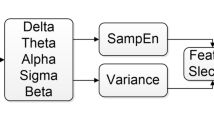Abstract
Sleep Apnea is a sleep disorder which causes stop in breathing for a short duration of time that happens to human beings and animals during sleep. Electroencephalogram (EEG) plays a vital role in detecting the sleep apnea by sensing and recording the brain’s activities. The EEG signal dataset is subjected to filtering by using Infinite Impulse Response Butterworth Band Pass Filter and Hilbert Huang Transform. After pre-processing, the filtered EEG signal is manipulated for sub-band separation and it is fissioned into five frequency bands such as Gamma, Beta, Alpha, Theta, and Delta. This work employs features such as energy, entropy, and variance which are computed for each frequency band obtained from the decomposed EEG signals. The selected features are imported for the classification process by using machine learning classifiers including Support Vector Machine (SVM) with Kernel Functions, K-Nearest Neighbors (KNN), and Artificial Neural Network (ANN). The performance measures such as accuracy, sensitivity, and specificity are computed and analyzed for each classifier and it is inferred that the Support Vector Machine based classification of sleep apnea produces promising results.










Similar content being viewed by others
References
Black, J. E., Guilleminault, C., Colrain, I. M., and Carrillo, O., Upper airway resistance syndrome - central electroencephalographic power and changes in breathing effort. Am. J. Respir. Crit. Care Med. 162(2):406–411, 2000. https://doi.org/10.1164/ajrccm.162.2.9901026.
Sugi, T., Kawana, F., and Nakamura, M., Automatic EEG arousal detection for sleep apnea syndrome. Biomed. Signal Process. Control 4(4):329–337, 2009. https://doi.org/10.1016/j.bspc.2009.06.004.
Guijarro-Berdiñas, B., Hernández-Pereira, E., and Peteiro-Barral, D., A mixture of experts for classifying sleep apneas. Expert Syst. Appl. 39(8):7084–7092, 2012. https://doi.org/10.1016/j.eswa.2012.01.037.
Almuhammadi, W. S., Aboalayon, K. A. I., Faezipour, M., Efficient obstructive sleep apnea classification based on EEG signals. IEEE Conference on Long Island Systems, Applications and Technology (LISAT), pp 1–6, 2015. https://doi.org/10.1109/LISAT.2015.7160186
Shahnaz, C., Tahseen Minhaz, A., Tanvir Ahamed, SK., Sub-frame based apnea detection exploiting delta band power ratio extracted from EEG signals. IEEE International Conference on Region 10 (TENCON), pp 190–193, 2016. https://doi.org/10.1109/TENCON.2016.7847987
Saha, S., Bhattacharjee, A., Abu Aeioub Ansary, MD., Fattah, S. A., An approach for automatic sleep apnea detection based on entropy of multi-band EEG signal. IEEE International Conference on Technologies for Smart Nation Region 10 (TENCON), pp 420–423, 2016.
Hsu, C.-C., Shih, P.-T., An intelligent sleep apnea detection system. IEEE Ninth International Conference on Machine Learning and Cybernetics, Qingdao, pp 3230–3233, 2010.
Zhou, J., Wu, X.-m., and Zeng, W.-j., Automatic detection of sleep apnea based on EEG detrended fluctuation analysis and support vector machine. Springer Sci. Bus. Media J. Clin. Monit. Comput. 29(6):767–772, 2015. https://doi.org/10.1007/s10877-015-9664-0.
Maali, Y., Al-Jumaily, A., A novel partially connected cooperative parallel PSO-SVM algorithm: study based sleep apnea detection. IEEE Conference in World Congress on Computational Intelligence, pp 1–8, 2012. https://doi.org/10.1109/CEC.2012.6256138
Koley, B. L., Dey, D., Classification of sleep apnea using cross wavelet transform. IEEE 1st International Conference on Condition Assessment Techniques in Electrical Systems (CATCON), pp 275–280, 2013. https://doi.org/10.1109/CATCON.2013.6737512
PhysioNet, PhysioBank ATM, https://www.physionet.org/physiobank/database/slpdb/
Chih-En, K., Sheng-Fu, L., Automatic stage scoring of single channel sleep EEG based on multiscale permutation entropy. IEEE Conference on Biomedical Circuits and Systems (BioCAS), pp 448–45, 2011. https://doi.org/10.1109/BioCAS.2011.6107824
Aboalayon, K. A. I., Almuhammadi, W. S., Faezipour, M., A comparison of different machine learning algorithms using single channel EEG signal for classifying human sleep stages. IEEE Conference on Systems, Applications and Technology (LISAT), pp 1–6, 2015. https://doi.org/10.1109/LISAT.2015.7160185
Aboalayon, K. A. I., Faezipour, M., Multi-class SVM based sleep stage identification using EEG signal. IEEE Conference on Health Innovations and Point-of- Care Technologies, pp 181–184, 2014. https://doi.org/10.1109/HIC.2014.7038904
Kempfner, J., Jennum, P., Sorensen, H. B. D., Christensen, J. A. E., Nikolic, M., Automatic sleep staging: from young adults to elderly patients using multi-class support vector machine. 35th Annual International Conference of the IEEE on Engineering in Medicine and Biology Society (EMBC), pp 5777–5780, 2013. https://doi.org/10.1109/EMBC.2013.6610864
Author information
Authors and Affiliations
Corresponding author
Ethics declarations
Ethical Approval
This article does not contain any studies with human participants or animals performed by any of the authors.
Additional information
Publisher’s Note
Springer Nature remains neutral with regard to jurisdictional claims in published maps and institutional affiliations.
This article is part of the Topical Collection on Image & Signal Processing
Rights and permissions
About this article
Cite this article
Vimala, V., Ramar, K. & Ettappan, M. An Intelligent Sleep Apnea Classification System Based on EEG Signals. J Med Syst 43, 36 (2019). https://doi.org/10.1007/s10916-018-1146-8
Received:
Accepted:
Published:
DOI: https://doi.org/10.1007/s10916-018-1146-8




